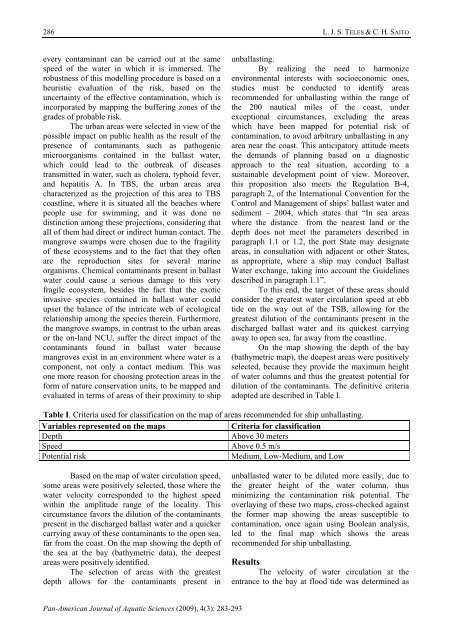Download full issue - PanamJAS
Download full issue - PanamJAS
Download full issue - PanamJAS
Create successful ePaper yourself
Turn your PDF publications into a flip-book with our unique Google optimized e-Paper software.
286<br />
L. J. S. TELES & C. H. SAITO<br />
every contaminant can be carried out at the same<br />
speed of the water in which it is immersed. The<br />
robustness of this modelling procedure is based on a<br />
heuristic evaluation of the risk, based on the<br />
uncertainty of the effective contamination, which is<br />
incorporated by mapping the buffering zones of the<br />
grades of probable risk.<br />
The urban areas were selected in view of the<br />
possible impact on public health as the result of the<br />
presence of contaminants such as pathogenic<br />
microorganisms contained in the ballast water,<br />
which could lead to the outbreak of diseases<br />
transmitted in water, such as cholera, typhoid fever,<br />
and hepatitis A. In TBS, the urban areas area<br />
characterized as the projection of this area to TBS<br />
coastline, where it is situated all the beaches where<br />
people use for swimming, and it was done no<br />
distinction among these projections, considering that<br />
all of them had direct or indirect human contact. The<br />
mangrove swamps were chosen due to the fragility<br />
of these ecosystems and to the fact that they often<br />
are the reproduction sites for several marine<br />
organisms. Chemical contaminants present in ballast<br />
water could cause a serious damage to this very<br />
fragile ecosystem, besides the fact that the exotic<br />
invasive species contained in ballast water could<br />
upset the balance of the intricate web of ecological<br />
relationship among the species therein. Furthermore,<br />
the mangrove swamps, in contrast to the urban areas<br />
or the on-land NCU, suffer the direct impact of the<br />
contaminants found in ballast water because<br />
mangroves exist in an environment where water is a<br />
component, not only a contact medium. This was<br />
one more reason for choosing protection areas in the<br />
form of nature conservation units, to be mapped and<br />
evaluated in terms of areas of their proximity to ship<br />
unballasting.<br />
By realizing the need to harmonize<br />
environmental interests with socioeconomic ones,<br />
studies must be conducted to identify areas<br />
recommended for unballasting within the range of<br />
the 200 nautical miles of the coast, under<br />
exceptional circumstances, excluding the areas<br />
which have been mapped for potential risk of<br />
contamination, to avoid arbitrary unballasting in any<br />
area near the coast. This anticipatory attitude meets<br />
the demands of planning based on a diagnostic<br />
approach to the real situation, according to a<br />
sustainable development point of view. Moreover,<br />
this proposition also meets the Regulation B-4,<br />
paragraph 2, of the International Convention for the<br />
Control and Management of ships’ ballast water and<br />
sediment – 2004, which states that “In sea areas<br />
where the distance from the nearest land or the<br />
depth does not meet the parameters described in<br />
paragraph 1.1 or 1.2, the port State may designate<br />
areas, in consultation with adjacent or other States,<br />
as appropriate, where a ship may conduct Ballast<br />
Water exchange, taking into account the Guidelines<br />
described in paragraph 1.1”.<br />
To this end, the target of these areas should<br />
consider the greatest water circulation speed at ebb<br />
tide on the way out of the TSB, allowing for the<br />
greatest dilution of the contaminants present in the<br />
discharged ballast water and its quickest carrying<br />
away to open sea, far away from the coastline.<br />
On the map showing the depth of the bay<br />
(bathymetric map), the deepest areas were positively<br />
selected, because they provide the maximum height<br />
of water columns and thus the greatest potential for<br />
dilution of the contaminants. The definitive criteria<br />
adopted are described in Table I.<br />
Table I. Criteria used for classification on the map of areas recommended for ship unballasting.<br />
Variables represented on the maps<br />
Criteria for classification<br />
Depth<br />
Above 30 meters<br />
Speed<br />
Above 0.5 m/s<br />
Potential risk<br />
Medium, Low-Medium, and Low<br />
Based on the map of water circulation speed,<br />
some areas were positively selected, those where the<br />
water velocity corresponded to the highest speed<br />
within the amplitude range of the locality. This<br />
circumstance favors the dilution of the contaminants<br />
present in the discharged ballast water and a quicker<br />
carrying away of these contaminants to the open sea,<br />
far from the coast. On the map showing the depth of<br />
the sea at the bay (bathymetric data), the deepest<br />
areas were positively identified.<br />
The selection of areas with the greatest<br />
depth allows for the contaminants present in<br />
unballasted water to be diluted more easily, due to<br />
the greater height of the water column, thus<br />
minimizing the contamination risk potential. The<br />
overlaying of these two maps, cross-checked against<br />
the former map showing the areas susceptible to<br />
contamination, once again using Boolean analysis,<br />
led to the final map which shows the areas<br />
recommended for ship unballasting.<br />
Results<br />
The velocity of water circulation at the<br />
entrance to the bay at flood tide was determined as<br />
Pan-American Journal of Aquatic Sciences (2009), 4(3): 283-293
















